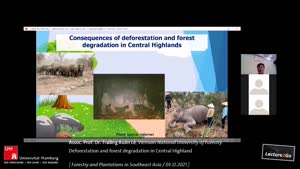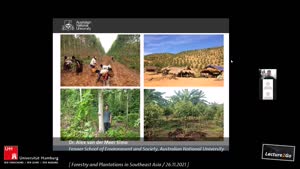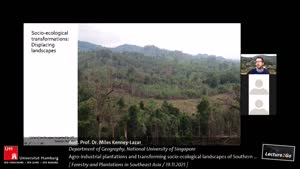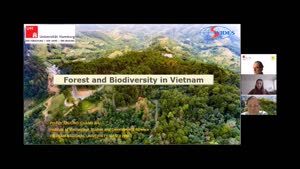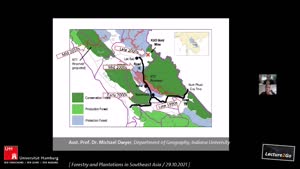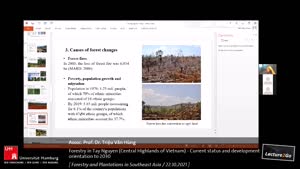Deforestation and forest degradation in Central Highland - Assoc. Prof. Dr. Trường Xuân Lê - Universität Hamburg
- Lecture2Go
- Videokatalog
- F.5 - Geisteswissenschaften
- Asien-Afrika-Institut
- Forestry and Plantations in Southeast Asia
Videokatalog
3484 Aufrufe
03.12.2021
Deforestation and forest degradation in Central Highland
Central Highlands (Vietnamese: Cao nguyên Trung phần), Western Highlands (Vietnamese: Tây Nguyên) or Midland Highlands (Vietnamese: Cao nguyên Trung bộ) is one of the regions of Vietnam. Central Highland can be divided into 3 subregions according to its deviation in topography and climate, namely: North Central Highland (Bắc Tây Nguyên) (inclusive of Kon Tum and Gia Lai provinces), Middle Central Highland (Trung Tây Nguyên) (covering provinces of Đak Lak and Đak Nong), South Central Highland (Nam Tây Nguyên) (Lam Đong). Middle Central Highland has a lower altitude and therefore has a higher temperature than the other two subregions. The region has an average altitude of 500–600 m with basalt soil, suitable for planting coffee tree, cacao, pepper, and white mulberry. Cashew and rubber plants are also planted here.
Central Highland contains in it many primitive forests and is protected in its national parks, such as Cat Tien National Park, Yok Đon National Park, Kon Ka Kinh National Park. Central Highland is home to the most prominent and also the most endangered species in Vietnam and Southeast Asia. Forest resources and forestry land areas in Tay Nguyen are facing the risk of serious attenuation due to different reasons, such as small unowned area of deep forest is being trespassed by newly arrived migrants for residential and production purposes (which rapidly increases the agricultural land in the whole region), as well as deforestation and illegal exploitation of forest products. Due to the attenuation of forest resources, the output of logging has been constantly decreasing, from 600 to 700 thousand cubic meters in the late 1980s - early 1990s to about 200-300 thousand cubic meters per year at the moment.
In recent decades, natural forests in Vietnam were continuously devastated, becoming one of the top problems in Vietnam. In particular, natural forests in the Central Highlands have been severely decreased. This has left enormous implications, from the destroyed ecological environment, the regressive traditional culture of about 20 ethnic minorities living here to the social insecurity. But most importantly, forests are the whole life of ethnic minority people and they depend on forests. Deforestation has already caused serious consequences to the environment, including erosion and drought. Forests retain water and prevent erosion. Deforestation causes erosion and makes soil poorer, leading to falling agricultural productivity.
Unscientific cultivation has caused a great loss of vegetation on the earth surface, leading to land erosion. Hundreds of hectares of production land and thousands of tonnes of nutrition and organic matter have eroded into the Mekong River and East Sea every year. In addition, the declining forest coverage reduced underground water, soil humidity and the microorganism population. The result is that farmland has become poorer and poorer. Some areas in the Central Highlands have annual droughts and even face risks of desertification.
Changing forest land into plantations comes with trade-offs, including harmful consequences to the environment and ecosystem, and more severe climate change impacts. Land degradation is seriously affecting Central Highlands provinces. The region has 5.4 million hectares of natural land, but forest areas have declined significantly due to loose management by authorities, leading to improper use. Scientists suggested restricting the use of forestland and reorganizing the plantation structure in the Central Highlands. They stressed that local farmers should diversify what they plant, rather than just planting coffee, in order to maintain an ecological balance. In 2019, the Prime Minister has recently approved a forest protection, restoration and development programme, aiming to increase forest cover in the Central Highlands to 49.2% by 2030.
Lê Xuân Trường is an Associate Professor specialising on forestry and silviculture. After graduating his B.Sc. and M.Sc. in Forestry at the Vietnam University of Forestry (now Vietnam National University of Forestry (VNUF)), conducting his Ph.D. program at Colorado State University in Forest Science, he has worked as a senior lecturer and Dean of Forestry Falculty at VNUF. He has worked in different projects, for example as a director for the Vietnam-Netherlands research program funded project “Study on the solutions for sustainable bamboo resources management in Ngoc Lac district-Thanh Hoa province”, the JICA funded project “Implement REDD+ through Forest Management Scheme in Dien Bien province”, the MARD funded project “Study on rehabilitation of Arundinaria sp.2 in some province in Northwest area for sustainable supplying material for export”. He was involved in several projects at different levels in the forestry sector. Next to that, he works as an independent consultant for both domestic and international organizations in Vietnam such as the State Union of Farmer, National Extension Center, REDD+ readiness preparation, Management Board of Forestry Project, JICA, JIPRO, IFAD, GIZ, LEAF.
---
“Forestry and Plantations in Southeast Asia (SEA)” is the topic of a two-semester series of classes. During the summer semester of 2021, the class has already covered insular SEA, especially Indonesia and the Philippines. In the fall-winter semester of 2021/22, the focus will be on continental SEA. Especially the Central Indochinese Highlands will be in the center of attention, and on the side of the three countries Vietnam, Laos and Cambodia. In recent decades, it is well known that so much natural forest area has been lost, so many hectares of plantations have been developed, starting in Vietnam, then spreading across the borders to Lower Laos and Northeastern Cambodia. The Vietnamese logging and plantation company Hoàng Anh Gia Lai is one prominent example. Similar processes occur in Northern Indochina as well, for instance along the Laos-China border. During the seminar and lecture series, we would like to raise some of the following questions, for example: How did deforestation happen, and how did the plantation industry grow - causes, processes, and consequences. How would forestry or ecology sciences, geography or sociology assess this matter? What could and should be to done to preserve the natural tropical rain forest? Are there are positive, effective methods to avoid the complete loss of natural tropical forests in the region of SEA, or is it doomed to disappear? The seminar includes a number of guest lectures from experts of the field who will give insights into the topic from different perspectives.
---
“Forestry and Plantations in Southeast Asia (SEA)” is the topic of a two-semester series of classes. During the summer semester of 2021, the class has already covered insular SEA, especially Indonesia and the Philippines. In the fall-winter semester of 2021/22, the focus will be on continental SEA. Especially the Central Indochinese Highlands will be in the center of attention, and on the side of the three countries Vietnam, Laos and Cambodia. In recent decades, it is well known that so much natural forest area has been lost, so many hectares of plantations have been developed, starting in Vietnam, then spreading across the borders to Lower Laos and Northeastern Cambodia. The Vietnamese logging and plantation company Hoàng Anh Gia Lai is one prominent example. Similar processes occur in Northern Indochina as well, for instance along the Laos-China border. During the seminar and lecture series, we would like to raise some of the following questions, for example: How did deforestation happen, and how did the plantation industry grow - causes, processes, and consequences. How would forestry or ecology sciences, geography or sociology assess this matter? What could and should be to done to preserve the natural tropical rain forest? Are there are positive, effective methods to avoid the complete loss of natural tropical forests in the region of SEA, or is it doomed to disappear? The seminar includes a number of guest lectures from experts of the field who will give insights into the topic from different perspectives.
Technischer Support
Bitte klicken Sie auf den nachfolgenden Link und füllen Sie daraufhin die notwendigen Felder aus, um unser Support-Team zu kontaktieren!
Link zu der RRZ-Support-Seite

